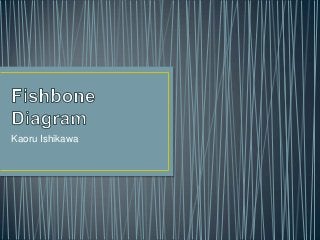
Report - Kaoru Ishikawa Fishbone Diagram
- 2. • He received his doctorate of philosophy in chemical engineering in 1939 from the University of Tokyo. • He wrote 647 articles and 31 books, including two that were translated into English. • He is well known for coming up with the concept for the fishbone shaped diagram, known as the Ishikawa or cause and effect diagram, used to improve the performance of teams in determining potential root causes of their quality problems.
- 3. • also known as the Ishikawa or the Cause and Effect diagram. • The fishbone diagram is a cause‐and‐effect diagram that can be used to identify the potential (or actual) cause(s) for a performance problem. • Causes can be derived from brainstorming sessions. These groups can then be labeled as categories of the fishbone.
- 4. • Watson, G., 2004. The Legacy of Ishikawa, Retrieved from http://www.gregoryhwatson.eu/images/6- QP_Watson_-_April2004_-_Legacy_of_Ishikawa.pdf